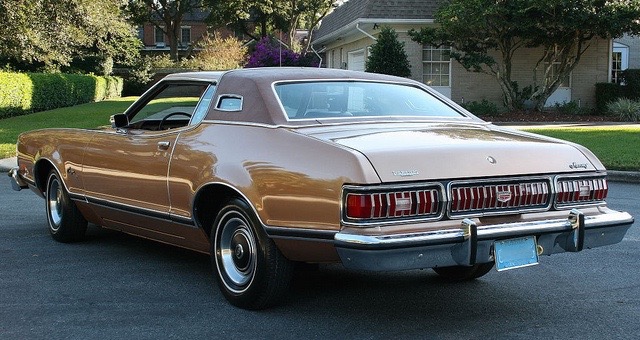Single fins of the vertical stabilizer kind found on aircraft occasionally were found on low-production, aerodynamically-styled cars during the 1920s and 30s. But tail fins mounted on rear fenders of cars can, for practical purposes, be treated as something initiated in Detroit styling studios after World War 2, though the style also was adopted by several non-American brands in the late-1950s and early 60s.
For the most part such tail fins were decorative, having little or no value regarding improving directional stability at high speeds. I recall an article in a contemporary car magazine stating that fin's shapes could easily be modified from one model year to the next as an inexpensive way to freshen a car's design.
Small tail fins appeared on 1948 Cadillacs and occasionally later as modest little humps on cars such as 1953-54 Pontiacs and Dodges.
Fins became a major styling fad when the sensational (at the time) 1957 Chrysler Corporation line appeared. Fins for these cars were part of the original design, but 1956 Chrysler products featured fins tacked onto 1955-vintage bodies in an attempt to allow the car-buying public to become familiar with the concept. During the rest of the 1950s some automobile makers included fins on new designs. Others did what Chrysler did for 1956, adding tail fins to existing designs.
The present post deals with the "tacked-on" variety on American brands of that era.
Gallery
1956 Chrysler Corporation's Transition Fins
1956 Chrysler New Yorker - Barrett-Jackson auction photo
1956 DeSoto - Barrett-Jackson auction photo
Chrysler and DeSoto had a nice fender line for 1955, kicking up behind the door as seen here, but then running slightly down from horizontal towards the rear. The 1956 fins destroyed the original design theme, so I never liked them even though my father owned a '56 DeSoto.
1956 Dodge - brochure page
1956 Plymouth Belvedere 2-door sedan - Barrett-Jackson auction photo
Dodge and Plymouth bodies were different from those of the senior Chrysler Corporation lines, so we find a different fin treatment. This one works better because the basic fender lines are not altered. At the same time, the fins are clearly fin-like in the context of a jet fighter or a Gold Cup racing hydroplane. Nevertheless, they detract from the 1955 styling themes for these brands.
Competing Brand's Fins on Older Bodies
1957 Ford Thunderbird
Thunderbird was introduced for the 1955 model year with a design that included details found on regular '55 Fords. One was the treatment of the tail light ensemble that gave T-Birds a slightly pinched look at the rear. Ford sedans were redesigned for 1957, but Thunderbird had to carry its '55 vintage design until 1958. One gift from large Fords to T-Birds was the canted tail fin shown here. This is one instance where an imposed tail fin actually improved matters, adding interest to the rear and achieving better balance for the car's side appearance.
1957 Lincoln
I consider the 1957 facelift for Lincoln one of the worst, most character-destroying of its day. (Though 1958 Oldsmobiles, Buicks and Cadillacs managed to top Lincoln on that score.) The fin shown here is an overly-large, characterless blade that doesn't integrate with the rest of the body. A more modest, more vertical fin would have worked better but still would have degraded a nice design.
1956 Lincoln
I include this photo of a 1956 Lincoln to illustrate the damage done by those fines. These Lincolns were large cars, but the '56 design was graceful.
1957 Hudson Hornet Hollywood
The final Hudson. Whatever virtues its 1952-vintage Nash body design had are thoroughly corrupted through ad-hoc ornamentation at this point, so the silly little tacked-on fins almost get lost in the confusion.
1956 Studebaker Golden Hawk - Mecum auction photo
The basic body is that of the classic Raymond Loewy 1953 Studebaker Starliner, but it got modified repeatedly after 1954. It's interesting that the Golden Hawk got fins the same year Chrysler began that fad. Moreover, they look better despite the intrusive two-tome paint scheme.
1957 Studebaker Golden Hawk
Still tack-on in the sense that the fins were not part of the original design, the '57 Hawk's fins are nicely integrated, as compared to most other examples shown here.

1958 Studebaker Commander
On the other hand, the fins added to Studebaker sedans are awkward, misshapen objects.
1958 Packard sedan - auction photo
Sadly, by 1958 Packards had been reduced to using Studebaker bodies such as the one in the previous image. The fins shown here are fussy, two-tiered affairs that unbalance the basic design.
1958 Rambler - brochure page
Rambler's new fins are modest, horizontal affairs. They aren't attractive, but the Rambler body introduced for 1956 was ill-proportioned and unattractive to begin with.























































